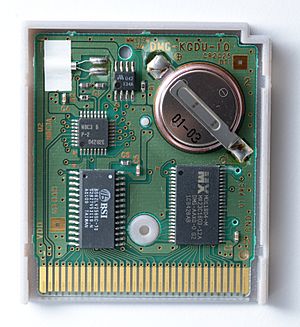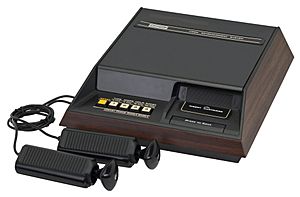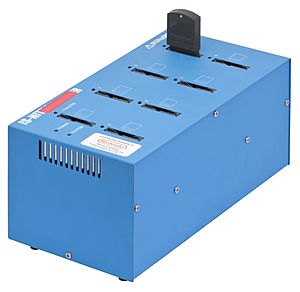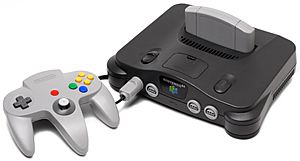Cartridge (electronics) facts for kids

A ROM cartridge is like a small, removable box that holds computer programs or games. You might know them as "game cartridges" because they were (and still are!) very popular for video game consoles. These cartridges contain a special type of memory called ROM, which means the information on them can be read but not easily changed.
Cartridges were used to quickly load software like video games or other programs onto devices. This was super helpful because it meant you didn't need expensive floppy disk drives or slow tapes. Some cartridges even had a small battery inside. This battery powered a special memory called static RAM, which allowed you to save your game progress or high scores!
One big plus for game makers was that cartridges were harder for people to copy illegally. However, they cost more to make than floppy disks or CD-ROMs. As technology improved and games got bigger, cartridges became less common for home consoles. But they are still used today for handheld gaming systems like the Nintendo DS, Nintendo 3DS, and the Nintendo Switch.
Contents
History of Game Cartridges

ROM cartridges first became popular with early home computers. These computers had special slots where you could plug in cartridges that held software. The first video game console to use these interchangeable cartridges was the Fairchild Channel F, released way back in 1976.
Many famous computers also used cartridges. These included the Commodore VIC-20, Commodore 64, Atari 8-bit family computers, and the Texas Instruments TI-99/4A. Even some arcade game systems, like Capcom's CP System and SNK's Neo Geo, used ROM cartridges for their games.
From the late 1970s to the mid-1990s, most home video game systems used cartridges. But then, compact discs became popular for storing data. Most companies switched from cartridges to CD-based game systems because CDs could hold more data and were cheaper to make.
Nintendo was one of the last big companies to stick with cartridges for their home console, the Nintendo 64. They didn't switch to disc-based games until the Nintendo GameCube in 2001. SNK also continued to release games on their cartridge-based Neo Geo system until 2004.
How Cartridges Can Add More Features

ROM cartridges aren't just for holding software. They can also contain extra hardware that adds new features to a game console. For example, some Super NES game cartridges had a special "Super FX" chip inside. This chip helped the console create more advanced 3D graphics.
Another cool example is the "J-Cart" design used by Codemasters for the game Micro Machines 2 on the Sega Genesis. This cartridge had two extra controller ports built right in! This meant up to four players could play at once without needing a separate adapter.
The idea of using small, removable memory chips continues today in many mobile devices. For instance, GPS navigation devices can update their maps by inserting a flash memory chip. E-book readers store thousands of books on tiny flash chips. Even Digital cameras use flash cards to store pictures.
Benefits and Drawbacks of Cartridges

Storing software on ROM cartridges has several good points compared to other ways, like floppy disks or optical discs.
- Super Fast Loading: Cartridges load games almost instantly. This is because the console can read the data directly from the cartridge, without waiting for slow disks to spin up.
- Less RAM Used: Games running from a cartridge often use less of the console's main memory (RAM). This leaves more RAM free for other things in the game.
- Different Sizes: Cartridges can be made in many different sizes. This is perfect for small devices like handheld game systems.
- Durable: While cartridges can get damaged, they are generally tougher than optical discs. If the contacts get dirty, cleaning them with rubbing alcohol usually fixes the problem.
However, cartridges also have some drawbacks:
- Less Storage: Cartridges typically hold less data than optical discs like DVD-ROMs or CD-ROMs.
- More Expensive to Make: Manufacturing cartridges is usually more costly than making discs.
- Risk for Makers: Game companies faced a risk of producing thousands of unsold cartridges, which could be a big financial loss.
As video games became more complex and needed more storage space, game makers started choosing optical media. Even though discs loaded slower, their larger capacity and lower cost made them a better choice for big games.
Cartridges in Music Instruments
Besides video games, ROM cartridges were also used in a small number of electronic keyboards and other musical instruments. They could store different sounds, rhythms, or even full songs for musicians to use.
Video Game Consoles That Used Cartridges
- Atari 2600
- Atari 5200
- Atari 7800
- Atari XEGS
- Atari Lynx
- Atari Jaguar
Fairchild Semiconductor
- NES/Famicom
- SNES/Super Famicom
- Nintendo 64
- Game Boy
- Game Boy Color
- Game Boy Advance
- Virtual Boy
- Pokémon mini
- Nintendo DS
- Nintendo 3DS
- Nintendo Switch
- SG-1000 Mark I/SG-1000 Mark II
- Sega Master System/Sega Mark III
- Sega Mega Drive/Genesis
- Sega Game Gear
- Sega Saturn
- Neo Geo
- Neo Geo Pocket

